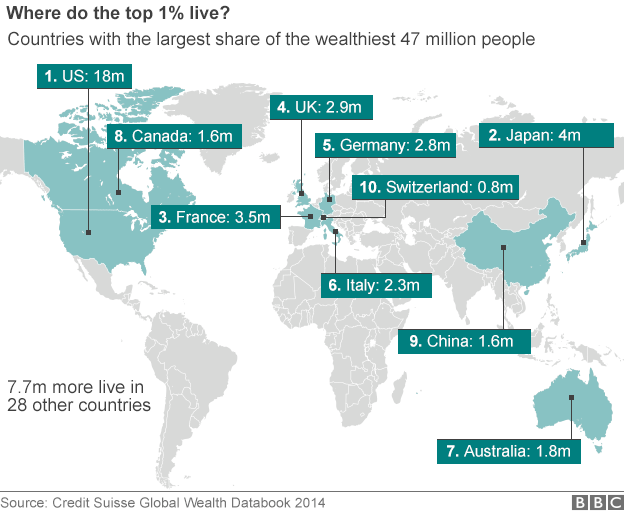From BBC News
As the business and political elite met at the World Economic Forum in Davos this week, there was much talk of rising inequality, and many references to the “wealthiest 1%”. The phrase conjures up images of billionaires living on private islands – but is that who the 1% really are?
A report by the charity Oxfam released to coincide with the Davos gathering caused a stir by predicting that the wealthiest 1% will soon own more than the rest of the world’s population.
It drew on research from the bank Credit Suisse, which estimated total global household wealth in 2014 at $263tn (£175tn).
That’s wealth, not income. It is calculated as assets minus debt.
Obviously billionaires like Bill Gates, Warren Buffett and Mark Zuckerberg are part of the 1%. But who else is? According to Credit Suisse, another 47m adults – everyone with wealth of $798,000 (£530,000) or more.
That includes many people in rich countries who may not regard themselves as particularly wealthy, but who simply own their house outright or have paid off a significant chunk off their mortgage.
Among them are:
- 18m people in the US – the country with more members of the 1% than any other
- 3.5m people in France
- 2.9m people in the UK
- 2.8m in Germany
Germany has the biggest economy in Europe. The reason it has fewer wealthy people – by Credit Suisse’s measure – is that it has lower levels of home ownership.
There are two Asian countries with more than a million people in the top 1%:
- 4m in Japan
- 1.6m in China
The country with the largest proportion of its population in the 1% per capita is Switzerland. One in 10 Swiss residents – 800,000 out of 8m – have assets worth more than $798,000.
But Credit Suisse’s report doesn’t tell the whole story.
It doesn’t take into account how much it costs to buy goods in each country, for example. Half a million pounds might buy a one-bedroom flat in central London, but in other countries it could buy a mansion.
It also doesn’t take into account income. As a result, many well-paid young people in Western countries may fall into the bottom 50% of wealth – either because they still have student debt to pay off, or because they know how to live well, and spend all their income.
If entry into the 1% does not guarantee a jet-set lifestyle, this is even truer when it comes to the cut-off point for the wealthiest 10% – for this you only need $77,000 (£50,000) of assets.
And the figure required to be in the top half of the world’s wealthiest is just $3,650 (£2,400).


